Click on images to enlarge
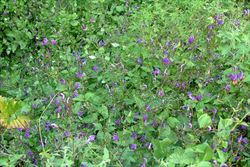
infestation (Photo: Sheldon Navie)
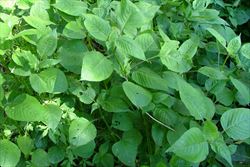
habit prior to flowering (Photo: Sheldon Navie)
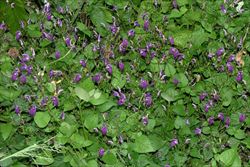
habit in flower (Photo: Sheldon Navie)
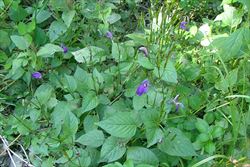
habit in fruit (Photo: Sheldon Navie)

paired leaves (Photo: Sheldon Navie)
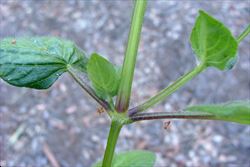
four-angled stem and hairy leaf stalks (Photo: Sheldon Navie)

branched flower cluster (Photo: Sheldon Navie)
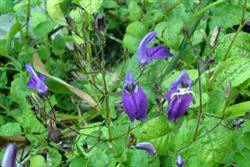
flowers (Photo: Sheldon Navie)

close-up of flower (Photo: Sheldon Navie)
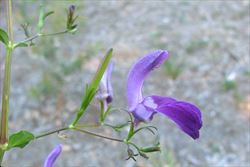
close-up of flower from side-on (Photo: Sheldon Navie)
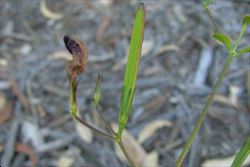
close-up of immature fruit (Photo: Sheldon Navie)
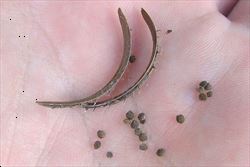
old fruit and seeds (Photo: Sheldon Navie)
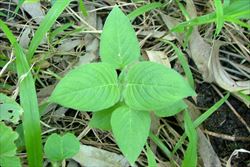
young plant (Photo: Sheldon Navie)
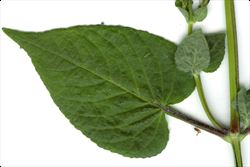
close-up of heart-shaped leaf with finely toothed margins (Photo: Sheldon Navie)
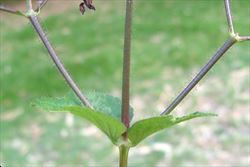
close-up of flower cluster branches, showing the numerous sticky hairs (Photo: Sheldon Navie)
Scientific Name
Brillantaisia lamium (Nees) Benth.
Synonyms
Leucorhaphis lamium Nees
Family
Acanthaceae
Common Names
brillantaisia, tropical giant salvia
Origin
Native to central and western Africa.
Cultivation
This species has occasionally been cultivated as a garden ornamental and has also been grown in botanic gardens.
Naturalised Distribution
Naturalised in northern and south-eastern Queensland. Brillantaisia (Brillantaisia lamium ) was first recorded in Australia in 1996 near Innisfail in northern Queensland. It has since been recorded from other parts of northern Queensland (i.e. from Cow Bay in the north to Japoonvale in the south), and more recently from Toowong, Mt. Coot-tha and The Gap in Brisbane.
Habitat
A weed of waterways, wetlands, orchards, plant nurseries and sugarcane plantations in tropical and sub-tropical regions. It also has the potential to colonise disturbed sites such as roadsides, agricultural clearings and gaps in forests in the wetter coastal districts of northern and eastern Australia.
Habit
A large branched herbaceous plant usually growing 0.5-1.5 m tall, but occasionally reaching up to 2 m in height. It is a short-lived (i.e. annual) plant with an upright (i.e. erect or ascending) habit.
Distinguishing Features
- a large upright herbaceous plant (up to 2 m tall) with four-angled stems.
- its oppositely arranged leaves are either egg-shaped in outline or heart-shaped.
- its violet, blue or dark purple flowers (20-30 mm long) are borne in loose, branched clusters at the tips of the stems.
- these flowers have two lobes, the upper being hooded and the lower being curved downwards.
- its fruit is an elongated capsule (about 30 mm long) that explosively releases its seeds.
Stems and Leaves
Its stems are somewhat hairy (i.e. pubescent) and square in cross-section (i.e. quadrangular). They are green or purplish-green in colour and bear leaves in pairs.
The leaves (up to 15 cm long and 7 cm wide) are usually borne on relatively long stalks (i.e. petioles), though the uppermost ones may be almost stalkless. They are sparsely covered with long soft hairs on both surfaces (i.e. pilose) and are egg-shaped in outline (i.e. ovate) or more commonly heart-shaped (i.e. cordate). The leaves also have entire or finely toothed (i.e. crenulate) margins and pointed tips (i.e. acute apices).
Flowers and Fruit
The violet or purple flowers (20-30 mm long) are borne in loose, branched clusters at the tips of the stems (i.e. in terminal panicles). These flowers have petals that are fused at the base into a tube (i.e. a corolla tube) about 6 mm long, and then separate into two lobes (i.e. they are two-lipped). The upper lobe is hooded, while the lower lobe is usually curved downwards and has three small teeth at its tip. Flowers also have five narrow green sepals (about 6 mm long) that are also fused together at the base (i.e. into a short calyx tube) and two stamens. Sticky (i.. glandular) hairs are usually present on the flowering branches and on the outer surface of the petals. Flowering can occur all year round, but is most common during summer.
The fruit is an elongated, cigar shaped (i.e. fusiform), capsule that turns from green to brownish in colour as it matures. These fruit (about 30 mm long) usually contain about 40 small flattened seeds. These seeds (about 1-1.5 mm long) are brown in colour and are covered in tiny close-lying (i.e. appressed) hairs.
Reproduction and Dispersal
Brillantaisia (Brillantaisia lamium ) reproduces by seed and also occasionally via stem fragments that can take root in damp environments.
The seeds are explosively released from the fruit when they are mature and they may be spread after becoming attached to animals and vehicles. Seeds and stem segments may also be dispersed by water, particularly during floods, and in dumped garden waste.
Environmental Impact
Brillantaisia (Brillantaisia lamium) is regarded as an environmental weed in Queensland and as a potential environmental weed or "sleeper weed" in other parts of northern Australia. It was also recently listed by the Commonwealth Department of Agriculture, Fisheries and Forestry as one of 17 Candidate Sleeper Weeds that have been targeted for eradication.
This species colonises recently disturbed land and occasionally forms large, monospecific stands. In Australia it has demonstrated a propensity to form dense stands along waterways. It causes serious impacts to riparian areas and other habitats in coastal areas, where it out-competes the native vegetation and impacts upon wildlife by reducing natural sources of food and shelter.
Brillantaisia (Brillantaisia lamium) has mainly been seen as a threat to the tropical parts of northern Australia, particularly in northern Queensland where it is more widely naturalised. However, dense stands have recently been found growing in sheltered areas in south-eastern Queensland in the middle of winter, suggesting that it might also be a significant threat to the sub-tropical regions of eastern Australia.
Other Impacts
This species is known to be weedy in western Africa, where it is native. It forms a dense understorey within plantation crops such as oil palms, cocoa, coffee and bananas. Hence, it has the potential to be a weed of similar crops in northern Australia.
Legislation
Not declared or considered noxious by any state government authorities.
Management
For information on the management of this species see the following resources:
- the Brisbane City Council Wipe Out Weeds brochure on this species.
Similar Species
Brillantaisia (Brillantaisia lamium) may be confused with closely related species such as native hypoestes (Hypoestes floribunda), ribbon plant (Hypoestes aristata) and polka-dot plant (Hypoestes phyllostachya). These species can be distinguished by the following differences:
- brillantaisia (Brillantaisia lamium) has relatively large leaves (up to 15 cm long and 7 cm wide) with broad (i.e. obtuse) or heart-shaped (i.e. cordate) bases. These leaves are green in colour and sparsely covered in long soft hairs (i.e. they are pilose). Its flowers are usually dark purple, blue or violet in colour and its fruit are relatively large (about 30 mm long).
- native hypoestes (Hypoestes floribunda) has relatively small leaves (1-9 cm long and 4-25 mm wide) with relatively narrow (i.e. cuneate) bases. These leaves are green in colour and sparsely hairy (i.e. sparsely pubescent). Its flowers are usually pink or mauve (occasionally white or purple) in colour and its fruit are relatively small (9-12 mm long).
- ribbon plant (Hypoestes aristata) has relatively large leaves (3-13 cm long and 1.5-9 cm wide) with narrow (i.e. attenuate) bases. These leaves are green in colour and sparsely covered in hairs (i.e. sparsely pubescent). Its flowers are pink to mauve-violet or purple in colour and its fruit are relatively small (8-12 mm long).
- polka-dot plant (Hypoestes phyllostachya) has relatively small leaves (up to 5 cm long and 2 cm wide) with broad (i.e. obtuse) to narrow (i.e. attenuate) bases. These leaves are dark green with distinctive pink to purplish spots and are sparsely hairy (i.e. sparsely pubescent). Its flowers are pink to pale purple in colour and its fruit are relatively small (8-12 mm long).

